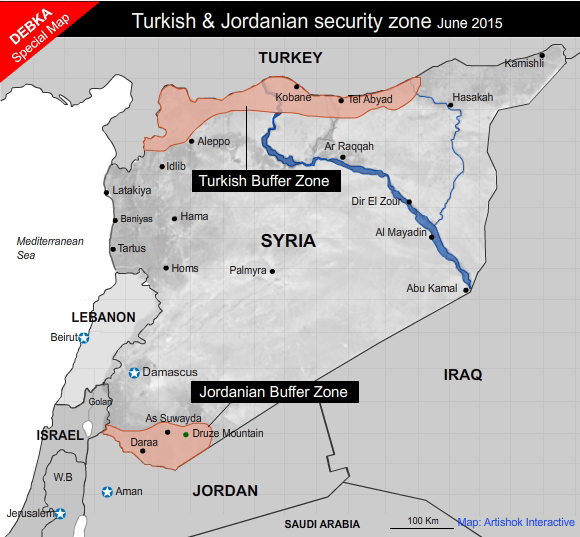Turkey and Jordan said preparing buffer zones inside Syria. Israeli air support mooted. Putin issues warning
DEBKAfile Special Report June 30, 2015,
The Turkish and Jordanian armies were reported on June 30 to be getting ready to cross into Syria for the first time since war engulfed that country in 2011, and set up security buffer zones. Both are impelled to fight ISIS, oppose the Assad regime and anxious to stem the flow of refugees, but there are also differences in their objectives and it is not clear if they are coordinated.
Turkey has prepared 18,000 troops to carve out a buffer zone in northern Syria and use its air force to impose a no-fly zone against Syrian flights. Middle East sources report that the Jordanian army is also on the ready to cross into southern Syria. Jordan and Israel are reported to be planning joint air cover and the creation of a parallel no-fly zone in the south.
These preparations prompted Russian President Vladimir Putin to pledge his support for the Assad regime .On Monday, June 29, Putin summoned Syrian Foreign Minister Walid al-Moallem to his Kremlin office from a meeting with Russian Foreign Minister Sergey Lavrov to tell him that Russia’s “policy to support Syria, the Syrian leadership and the Syrian people remains unchanged.”
Putin has repeatedly warned Western governments against military intervention in the Syrian war or any attempt to oust Bashar Assad, warning that if foreign troops go into Syria, Moscow will respond in kind.
The Russians have not spelled out what action is contemplated, but they have options: they maintain naval and marine forces in the Mediterranean and Black Sea regions able to reach Syria at short notice. South Russian air force bases are also close enough to interfere with no-fly zones being setup over Syria.
Possible outside military intervention in Syria was the dominant topic in the phone call the Russian president put through to President Barack Obama on June 26. The communiqués in Moscow and Washington both referred to the “dangerous situation” in Syria. The two presidents also discussed the prospects of the nuclear accord shaping up with Iran, and the two issues may have been linked. The White House later stated that President Obama had stressed the need for the world powers to hold to a united stand in the negotiations with Iran.
Sources in Ankara claim that President Recep Tayyip Erdogan has already given Turkish units their orders to go into Syria, although this is not confirmed. Others use the term “Western intervention” – suggesting that US and NATO are involved in the Turkish initiative. This may refer to US Air Force squadrons based in southern Turkey possibly providing air cover.
Western and Middle East sources report that the Jordanian plan entails a joint operation with Syrian rebel forces to carve out a security zone in southern Syria running from Jabal Druze and Suwayda in the east running west through the town of Deraa and up to the intersection of the Jordanian-Syrian-Israeli borders.
Fierce fighting has been raging in this part of Syria in recent days as the rebels battle Syrian-Hizballah forces in an attempt to push them out and capture southern Syria. So far they have not made it.
The never-ending refugee problem from Syria is a major headache for the two governments. Turkey hosts some two million refugees and Jordan more than a million and a half. Stemming this flow is not the least of the goals of their buffer zone plans.






















